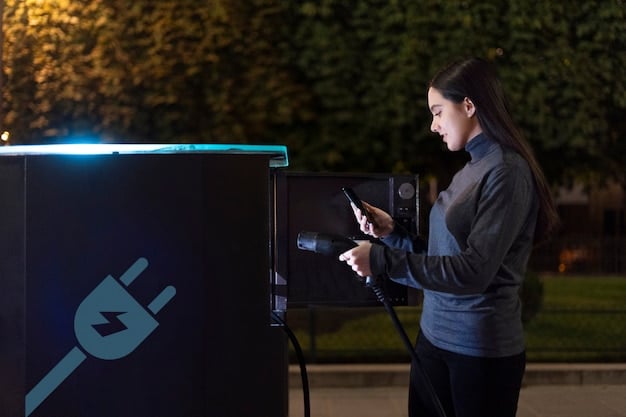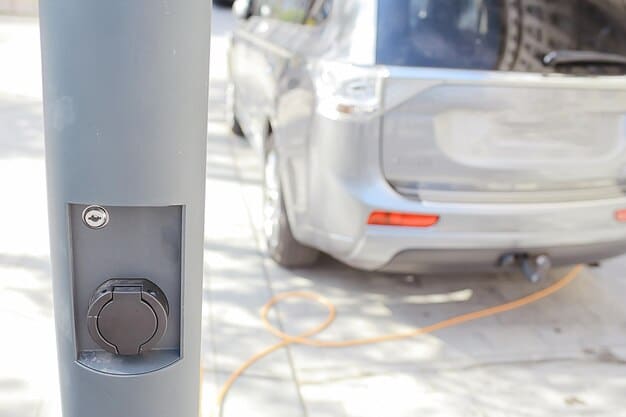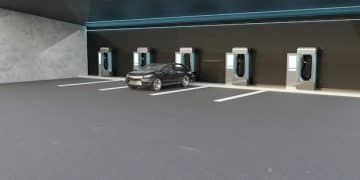Latest US Government Incentives for Electric Vehicle Adoption & Sales Impact

The latest government incentives for electric vehicle (EV) adoption in the US include substantial tax credits, rebates, and funding for charging infrastructure, significantly influencing EV sales by lowering the upfront cost and enhancing accessibility for consumers.
The automotive industry is undergoing a significant transformation with the rise of electric vehicles (EVs). Governments worldwide, including the US, are implementing various incentives to accelerate the adoption of EVs. Understanding what are the latest government incentives for electric vehicle adoption in the US and how do they affect sales is crucial for both consumers and industry stakeholders.
Understanding Federal Tax Credits for Electric Vehicles
The federal government offers tax credits to incentivize the purchase of new electric vehicles. These credits can significantly reduce the upfront cost of an EV, making them more accessible to a broader range of consumers. Understanding the specifics of these credits is essential for anyone considering purchasing an EV.
The Inflation Reduction Act of 2022
The Inflation Reduction Act of 2022 has reshaped the landscape of EV tax credits. This act introduced significant changes to eligibility requirements and credit amounts, aiming to boost domestic manufacturing and promote cleaner transportation.
Eligibility Requirements for the Federal Tax Credit
To qualify for the federal tax credit, EVs must meet certain criteria related to battery components and manufacturing location. These requirements are designed to encourage domestic production and reduce reliance on foreign supply chains.
- Manufacturing Location: The vehicle must be assembled in North America to be eligible for the credit.
- Battery Components: A certain percentage of the battery components must be manufactured or assembled in North America.
- Income Limits: The Inflation Reduction Act introduces income limits for buyers to ensure the credit benefits those who need it most.

The federal tax credit plays a vital role in lowering the financial barrier to EV adoption. By understanding the eligibility criteria and credit amounts, consumers can make informed decisions and take advantage of these incentives.
State-Level Incentives for Electric Vehicle Adoption
In addition to federal incentives, many states offer their own programs to encourage EV adoption. These state-level incentives can include rebates, tax credits, and other financial benefits. Exploring these options can further reduce the cost of owning an EV.
Rebates and Tax Credits by State
Several states offer rebates or tax credits for EV purchases. These incentives vary in amount and eligibility requirements, so it’s essential to research the specific programs in your state.
California’s Clean Vehicle Rebate Project (CVRP)
California’s Clean Vehicle Rebate Project (CVRP) provides rebates for eligible electric vehicles. The amount of the rebate depends on factors such as income and vehicle type, with higher rebates available for lower-income individuals.
State-level incentives complement federal programs, providing additional financial support for EV buyers. By combining federal and state incentives, consumers can significantly reduce the overall cost of purchasing and owning an EV.
Local Utility Incentives and Rebates for Electric Vehicles
Beyond federal and state incentives, local utility companies often provide rebates and other benefits to encourage EV adoption. These incentives can range from discounts on charging equipment to reduced electricity rates for EV owners. Leveraging these local programs can further lower the cost of EV ownership.
Charging Equipment Rebates
Many utilities offer rebates on the purchase and installation of home charging equipment. These rebates can help offset the cost of installing a Level 2 charger, which significantly reduces charging times compared to standard wall outlets.
Time-of-Use Rates for EV Charging
Some utilities offer time-of-use rates for EV charging, which provide lower electricity rates during off-peak hours. By charging their vehicles during these times, EV owners can save money on their electricity bills.

Local utility incentives play a crucial role in making EV ownership more affordable and convenient. By taking advantage of these programs, EV owners can reduce their charging costs and contribute to a cleaner energy future.
The Impact of Incentives on Electric Vehicle Sales Trends
Government incentives have a direct and measurable impact on electric vehicle sales trends. By reducing the upfront cost and providing other financial benefits, incentives make EVs more attractive to consumers. Analyzing sales data reveals the effectiveness of these programs.
Sales Data and Incentive Effectiveness
Studies have shown a strong correlation between government incentives and EV sales. States with more generous incentives tend to have higher EV adoption rates. These incentives can accelerate the transition to electric vehicles.
Consumer Behavior and Incentive Programs
Incentive programs influence consumer behavior by making EVs more competitive with traditional gasoline-powered vehicles. The availability of tax credits, rebates, and other financial benefits can sway consumers to choose an EV over a conventional car.
- Purchase Decisions: Incentives directly impact purchase decisions by reducing the overall cost of EV ownership.
- Adoption Rates: Higher incentives correlate with higher EV adoption rates in specific regions.
- Market Growth: Incentives accelerate the growth of the EV market by attracting more consumers.
Government incentives are a key driver of EV sales growth. By understanding the impact of these programs, policymakers can refine their strategies to further promote EV adoption and reduce emissions.
Infrastructure Development and Its Role in Electric Vehicle Adoption
The availability of charging infrastructure is a critical factor influencing electric vehicle adoption. Government funding and private investment in charging stations are essential to support the growing number of EVs on the road. A robust charging network makes EV ownership more convenient and accessible.
Government Funding for Charging Infrastructure
The federal government is investing billions of dollars in charging infrastructure through various programs. These investments aim to build a nationwide network of charging stations, ensuring that EV owners can easily find a place to charge their vehicles.
Private Investment in Charging Networks
Private companies are also investing heavily in charging networks. These companies are deploying charging stations in convenient locations such as shopping centers, workplaces, and highway rest stops.
Infrastructure development is essential to support the widespread adoption of EVs. By investing in charging stations, governments and private companies are making EV ownership more practical and convenient for consumers.
Future Trends in Government Incentives for Electric Vehicles
Government incentives for electric vehicles are likely to evolve in the coming years. As the EV market matures and technology advances, incentive programs may shift to focus on different goals, such as promoting equity and supporting domestic manufacturing. Staying informed about these future trends is crucial for both consumers and industry stakeholders.
Potential Changes to Federal Tax Credits
The federal tax credit for EVs could be modified to address challenges such as affordability and domestic production requirements. Policymakers may consider adjustments to income limits or battery sourcing rules.
New State-Level Initiatives
States may introduce new incentives to complement federal programs. These initiatives could include additional rebates, tax credits, or policies to support the development of charging infrastructure.
Government incentives will continue to play a vital role in shaping the future of electric vehicles. By adapting to changing market conditions and technological advancements, incentive programs can effectively promote EV adoption and reduce emissions.
| Key Point | Brief Description |
|---|---|
| 💰 Federal Tax Credit | Reduces EV purchase price via tax credit, influenced by the Inflation Reduction Act. |
| 🌎 State Incentives | Includes rebates and tax credits, varying by state (e.g., California’s CVRP). |
| 🔌 Utility Rebates | Offers rebates for charging equipment and reduced electricity rates. |
| 📈 Sales Impact | Directly increases EV sales by lowering costs and improving affordability. |
Frequently Asked Questions (FAQ)
▼
The federal tax credit is a financial incentive offered by the US government to reduce the cost of purchasing a new electric vehicle. It can significantly lower the upfront expense, making EVs more accessible.
▼
State incentives vary, often including rebates or tax credits. These can be combined with federal incentives for greater savings. California’s Clean Vehicle Rebate Project is a well-known example.
▼
Local utilities provide incentives like rebates for home charging equipment. Some also offer time-of-use rates, allowing EV owners to save on electricity costs by charging during off-peak hours.
▼
Incentives boost EV sales by making them more affordable. Studies show a direct correlation between incentive generosity and EV adoption rates, indicating their effectiveness in promoting EV use.
▼
A robust charging network is vital for EV adoption. Government and private investments in charging stations are crucial in making EV ownership more convenient by providing accessible charging options.
Conclusion
Government incentives play a crucial role in accelerating the adoption of electric vehicles in the US. By understanding the various federal, state, and local programs available, consumers can make informed decisions and take advantage of the financial benefits offered. These incentives, coupled with investments in charging infrastructure, are driving the growth of the EV market and contributing to a cleaner, more sustainable transportation future.





